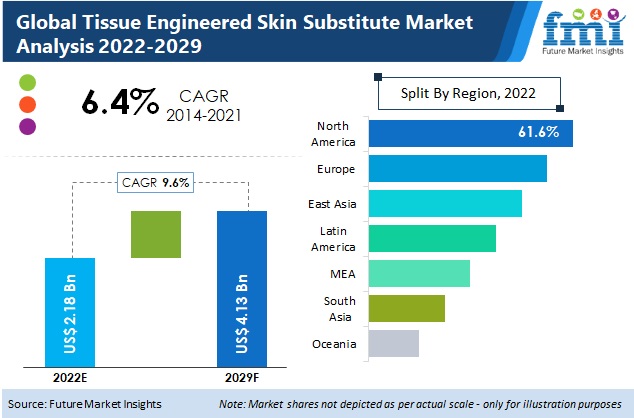[248 Pages Report] Rapid expansion of wound management space has argued well for the growth in demand for tissue engineered skin substitutes. The global tissue engineered skin substitute market is projected for a robust 9.6% CAGR during 2022 – 2029, predominantly driven by high applicability in diabetic foot ulcers and other chronic wounds.
With advent of tissue engineering and improved ability to combine advanced manufacturing technologies with biomaterials and cell culture systems, more biomimetic tissue constructs have been emerged. Technological advancements are leading to production of advanced tissue engineered skin substitutes. 3D bioprinting and biotextile are emerging as popular biofabrication strategies for creating bioengineered skin substitutes. A team of researchers in the U.S. recently discovered a technology for complete 3D printing of the living skin along with blood vessels. Emergence of such revolutionary fabrication technologies will create a massive opportunity in the global market.

Key Takeaways – Tissue Engineered Skin Substitute Market Study
- With increasing researches in tissue engineering, the demand for biologic skin substitute is expected to increase in the forecast period. For instance, a team of engineers at the California Institute of Technology (Caltech) and ETH Zurich have developed an artificial skin made from pectin, a naturally occurring long-chain molecule present in plant cell walls allowing the construction of natural and new dermis.
- Increasing prevalence of diabetes and chronic wounds is boosting the demand for tissue engineered skin substitutes.
- The demand for tissue engineered skin substitutes in emerging economies such as China and India is expected to increase owing to increasing incidence of diabetic foot ulcers, venous leg ulcers, and pressure ulcers.
Despite breakthrough innovations assisting the growth of market, certain limitations are still there. The inability of tissue engineered skin substitutes to produce skin appendages such as hair follicles, sebaceous glands, and nails continues to remain among the most concerning challenges facing R&D teams
To remain ahead of your competitors, request for a sample – https://www.futuremarketinsights.com/reports/sample/rep-gb-781
Leading Manufacturers Setting the Pace for Product Innovations
The tissue engineered skin substitute market is a consolidated market. The tier 1 companies in the tissue engineered skin substitute market such as Allergan Plc., Mimedex Group Inc., Integra LifeSciences Corp. and Integra LifeSciences Corp. are expected to hold more than half of the total revenue generated by tissue engineered skin substitutes. The key players in the market are reshaping their current product portfolio by focusing on the introduction of new and advanced technologies and innovating new products.
Seeking More Insights?
Tissue engineered skin substitute market, a new study from Future Market Insights, opines on the evolution of tissue engineered substitute market from 2014 – 2021 and presents demand projections from 2022 – 2029 on the basis of; product (acellular skin substitute, biologic skin substitute, cellular skin substitute and synthetic substitute), material (synthetic and natural), application (chronic wound, acute wound and other applications such as breast reconstruction etc.) and end user (hospital, specialty clinics, ambulatory surgical centres and research laboratories) across seven prominent regions.
Get a Tailored Made Report to Match Your requirements, Ask from Market Research Expert – https://www.futuremarketinsights.com/ask-question/rep-gb-781
Tissue Engineered Skin Substitute Market by CategoryBy Product:
- Acellular Skin Substitutes
- Acellular skin substitutes based on Amniotic Membrane
- Other Acellular skin substitutes
- Biologic Skin Substitute
- Allograft
- Xenograft
- Cellular Skin Substitutes
- Cellular skin substitute based on amniotic membrane
- Other cellular skin substitutes
- Synthetic Skin Substitutes
By Material:
- Synthetic
- Natural
By Application:
- Chronic Wounds
- Venous leg Ulcers
- Diabetic Foot Ulcer
- Pressure Ulcers
- Acute Wounds
- Traumatic Wounds
- Burn Cases
- Other Applications
By End User:
- Hospital
- Specialty Clinics
- Ambulatory Surgical Centers
- Research Laboratory
By Region:
- North America
- Latin America
- Europe
- South Asia
- East Asia
- Oceania
- Middle East and Africa (MEA)
For in-depth competitive analysis, Buy Now – https://www.futuremarketinsights.com/checkout/781
About FMI:
Future Market Insights (FMI) is a leading provider of market intelligence and consulting services, serving clients in over 150 countries. FMI is headquartered in Dubai, the global financial capital, and has delivery centers in the U.S. and India. FMI’s latest market research reports and industry analysis help businesses navigate challenges and make critical decisions with confidence and clarity amidst breakneck competition. Our customized and syndicated market research reports deliver actionable insights that drive sustainable growth. A team of expert-led analysts at FMI continuously tracks emerging trends and events in a broad range of industries to ensure that our clients prepare for the evolving needs of their consumers.
Contact Us:
Unit No: AU-01-H Gold Tower (AU), Plot No: JLT-PH1-I3A,
Jumeirah Lakes Towers, Dubai,
United Arab Emirates
For Sales Enquiries: sales@futuremarketinsights.com
For Media Enquiries: press@futuremarketinsights.com
Website: https://www.futuremarketinsights.com